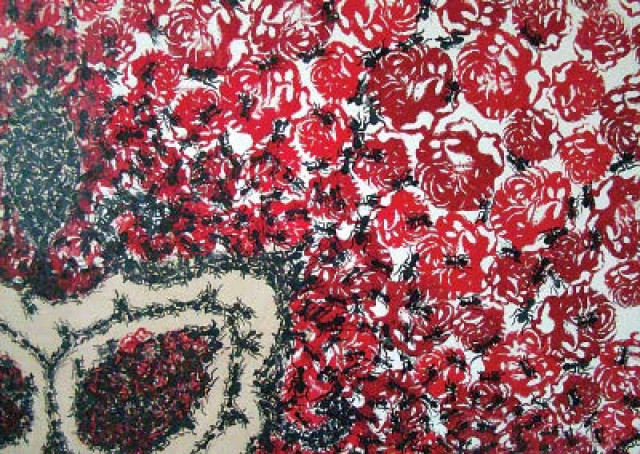
People with entomophobia - fear of insects - must avoid the Chawkandi Art Gallery on Saturday (today). Those who enjoy illusions, however, will love Muhammad Atif Khan’s prints being displayed in a show titled ‘Anthropology’ between 5:30 pm and 8:30 pm.
The artist has used millions of stamps of ants, moths and flies in his prints. He feels they describe the study of human kind and culture - anthropology. Speaking to The Express Tribune on the phone, Khan compared people to insects.
“It is relevant in a number of ways,” he explained. Ant colonies “symbolise the rise in population”, the insignificant working class and how “people are ignored unless they have power”. Trying to portray every insect analogy that comes to mind, the work ranges from creepy-crawly handwriting in ‘Love Letter’ to white noise in a scrambled television channel.
In an amusing contrast to his rather sombre ideas, Khan could not talk about his work without intermittently bursting into giggles. ‘Flying Carpet’, a print that is meant to look like a patterned carpet from afar but is actually a tangle of roses infested with ants, is a sad realisation of the complications that come with romance. “As wonderful as love is, reality is not quite as beautiful,” he observed, laughing nervously.
Visitors can also expect a recurring theme of the outdated “gol” (convex) television screens that were pushed out by flat screens and LCDs. ‘Wait and see’ is an image lodged in the artist’s mind from his childhood. “PTV was the only channel and when transmission was lost people would stare blankly at the ‘Intizaar Farmaye’ [please wait] bulletin for half an hour until the show was restored. It is about how the pace of the world has quickened, while holding a lot of nostalgia for me,” he reminisced.
On a more socially relevant note, ‘Order of the World’ and ‘The end’ is a series that roughly portrays North America’s position as a world power. Khan also spoke of the Pakistani preoccupation with ‘Amreeka’ and the perception that “there is nothing ahead of that country” - the destination to be all and end all.
The pieces, some that took months to create, were stamped on acrylic sheet. Some are multi-layered to appear three-dimensional. While the larger illusions, like ‘Flying Carpet’ went through multiple drafts and scaling, the work on paper “was made later and are more spontaneous,” with interesting images forming unintentionally. The full effect of the optical illusions only comes through when one sees it in person, an opportunity open to everyone tonight.
Published in The Express Tribune, March 26th, 2011.


















COMMENTS
Comments are moderated and generally will be posted if they are on-topic and not abusive.
For more information, please see our Comments FAQ